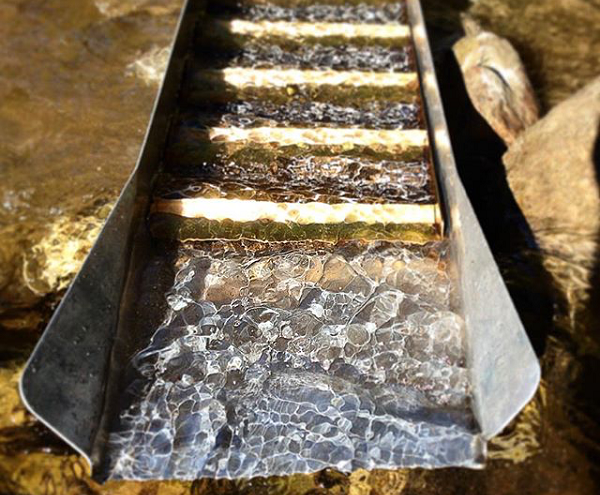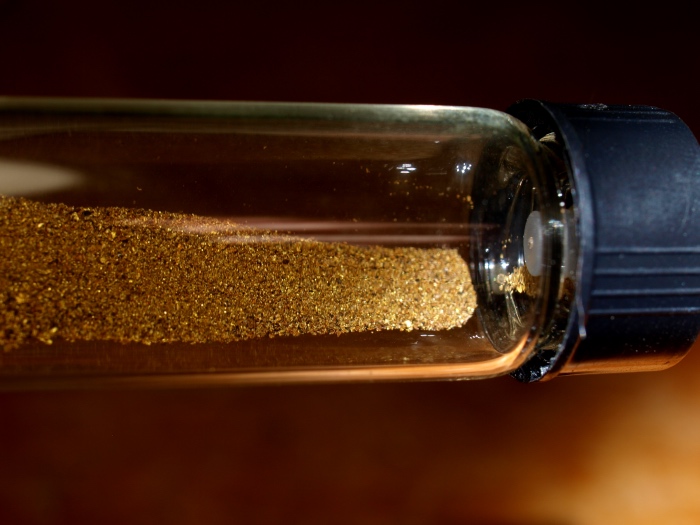
Using a standard sluice box is a great way to find gold. They are simple, lightweight, and can be used in most creeks and rivers to separate fine gold from sand and gravel. Most commercially-made sluice boxes are very good at catching and holding gold, but a few extra precautions can help you get more gold after a long day of mining.
Classify your Material
Big rocks tumbling through a sluice box will only cause trouble. They will dislodge gold that is already trapped in your sluice and cause it to be lost out the back.
To avoid this, it may be a good idea to use a classifier to separate the larger rocks from the finer material. This creates consistency in the material that flows overtop the riffles of the sluice, and will help to retain even finer gold particles than you would by just shoveling material directly into the box.
Use Specialized Miner’s Moss
Miner’s moss is one of the best inventions to come about in recent history. It is designed to lay under the expanded metal riffles of a sluice and works amazingly well at catching and holding fine gold particles and flakes. Prior to miner’s moss, regular carpet material was used and it worked ok, but it would still lose more gold than miner’s moss.

Don’t Lose Your Gold in the Clay!
Clays are a real problem in many areas. It will clump up and hold onto small gold particles, preventing them from settling down into the riffles of a sluice box the way it is designed to work. If you are prospecting in an area that has heavy clays in the soil, you need to find a way to break up this material so that the gold can be released.
There are a few ways to do this. If you are in an area with heavy clay soils, then classifying is really important to do. You will find that this process will help to break up dirt clods that attract the gold.
Physically using your hands to bust up heavy clays works well also. You will need to feed the sluice box slower than you normally would if you have to deal with clay to allow the sluice to work more efficiently.
Feed the Sluice Slowly
It is common for beginners to put too much material in the sluice box too quickly when they are first starting out. This prevents the sluice from working properly, and will clog up the riffles which will allow the gold to simply tumble over the top of them and out the back of the sluice. Make sure you feed gravel into your sluice box at the proper speed.

Fine gold like this can easily be blown out of your sluice box if you don’t have it set up properly. Keep the water flows just fast enough to discharge lighter material, don’t feed it to fast, and always monitor your riffles to make sure everything is working smoothly.
Proper Water Flow through the Sluice Box
If the water going through your sluice box is too slow, the riffles will quickly clog up with lighter materials like sand and gravel, and you will have a hard time catching much gold. If the water is moving through too quickly, then gold will get caught up in the turbulence of the whitewater and get lost out the back. Experiment with the flow through your sluice and make sure you have it set up properly.
Also Read: Focus Prospecting Efforts on Fine Gold Placers
And: Classify your Gravels to Retain More Fine Gold
Do a Final Cleanup More Often
Most of the time, you will be alright if you just do a final cleanup of your sluice at the end of the day. However, in some locations, particularly areas that have an abundance of heavy material like black sands, you many need to do a clean-up of your sluice box a few times per day. This will make ensure that your sluice is working properly.
When you do a final cleanup, be extra careful when taking your sluice box out of the water. Carefully remove it in a way that no material is lost. Slowly tip it into a bucket, break the sluice apart, and make sure it is washed out carefully.
It is also a good idea to look it over before tipping into a bucket to see if there are any visible gold nuggets or pickers that you can remove with tweezers.
Next: How to Prevent Fine Gold from Floating out of your Pan







